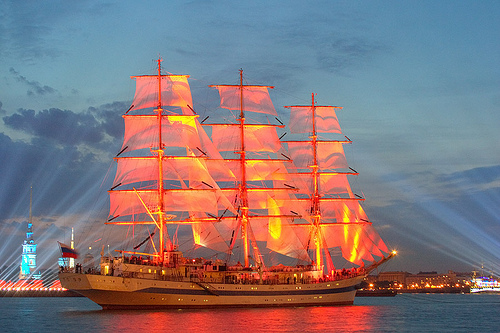| Location: Eastern Europe, the Eastern shore of the Baltic Sea (Gulf of Finland)
St.Petersburg is the northernmost major city of the world. It is located at 59°57' Latitude North, that passes roughly across the South of Alaska and Greenland. Stockholm, Oslo, and Helsinki can boast of being at the same latitude. Warm Gulfstreem seriously influences all these cities. There are no large cities at this latitude, as well as the latitudes close to it in the Western Hemisphere. Pulkovo Meridian 30°19' (Longitude East), passes through St.Petersburg as well as through Istanbul, but none of these cities can be compared to St.Petersburg in climate or nature.
The city is advantageously located at the sea routes and on land roads (12 radii of railroads and 11 highways). This is the European gateway of Russia, it's a strategic center, which is closest to the European Union countries of Russia, and it's a strategic center, which is closest to the European Union countries.
|

|
Due to the city's northern position it enjoys the phenomenon of the "White nights" , lasting from May 25-26 till July 16-17. July 22, the Solstice Day is the longest day (18 hours 53 minutes). The sun hardly hides behind the horizon, and you cannot find even the brightest stars in the night sky. The shortest day is December 22 (5 hours 52 minutes).
Although the phenomenon known as the "White Nights" is not unique to St Petersburg, in no other northern city have they received such poetic and literary acclaim. What could be more romantic than a walk along the banks of the city's rivers and canals in almost broad daylight, no matter what the time of day? No other major European city can rival this experience nor the atmosphere on the streets of St. Petersburg during the summer months - lively, friendly, romantic and bustling with people throughout the night as well as the day!
St.Petersburg is located at the mouth of the Neva River, and across the islands of its delta on the coast of the Finnish Gulf of the Baltic Sea. Its nearest suburbs are situated on the lowland adjacent to the Neva River, and along the Gulf. In spite of the general lowland nature of the site, the relief of the suburbs shows diversity. Izhora eminence is to the South of the city, and hilly Karelia Isthmus with Vuoksa lake land is located to the North.
The Neva River is the city's main waterway. The name of the river derives from the ancient name of Lake Ladoga, the Neva where it begins. The Neva is 74 kilometers long, flowing 32 kilometers within the city boundaries. The average width of the Neva within the city is 600 meters, depth - up to 24 meters. In the delta, the Neva splits into three main branches: the Bolshaya Neva, the Malaya Neva and the Bolshaya Nevka.
|
| St. Petersburg is often threatened by floods as most of its downtown territory is located just several feet above sea level. The founder of the city, Peter the Great, had chosen a very low-lying area on which to build St. Petersburg and from its very foundation, floods were a major problem. In August 1703, three months after the city was founded, the waters of the Neva River rose 6 feet above normal levels and washed away construction materials for the Peter and Paul Fortress. The city has experienced over 270 major floods since then. In the 1970s the decision was taken to build a long dam across the Gulf of Finland (west of St. Petersburg), which would protect the city from the affects of the floods. However, the project was not completed due to a huge environmental controversy and a lack of funding. Meanwhile, the problem is far from solved and the city awaits the next major flood with a distinct air of apprehension. |